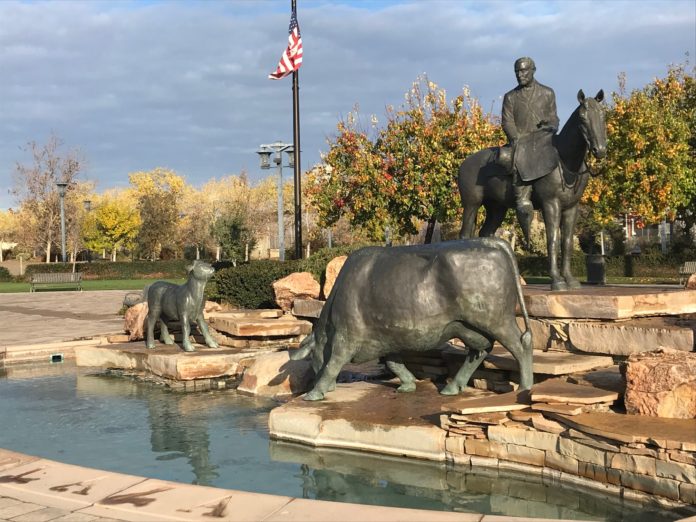The Exchange Contractors board of directors met on Friday, November 4, 2022 at its Los Banos headquarters and by telephone. Is there such a thing as numerical dyslexia? I kept typing in the wrong pass code and joined late. But I write the following with great confidence based on decades of experience. The meeting was called to order by Chairman Chris Cardella at 9:00am, the agenda was reviewed and approved, as were the minutes. As for public comment I can’t even guess. The phone connection doesn’t allow one to know who else is participating and unless you’re part of the show when Executive Director Chris White welcomes everyone and asks those calling in, “Hi, who the hell are ya?” there’s no way of knowing without interrupting the meeting.
confidence based on decades of experience. The meeting was called to order by Chairman Chris Cardella at 9:00am, the agenda was reviewed and approved, as were the minutes. As for public comment I can’t even guess. The phone connection doesn’t allow one to know who else is participating and unless you’re part of the show when Executive Director Chris White welcomes everyone and asks those calling in, “Hi, who the hell are ya?” there’s no way of knowing without interrupting the meeting.
The Meeting
I tuned in in time to hear Water Master Adam Hoffman say things are better at San Luis at this time compared to last year. Shasta Reservoir is low and the target is four million acre feet this year to avoid a critical year designation. Salinity in the Delta is restricting pumping and there probably won’t be more than one pump at the Jones Plant running until more inflow hits the Delta.
As for the recent storm the American River watershed received an inch. A new system is coming in and Shasta is expected to get two inches and the American and Feather Rivers’ could get four inches. That portion of the state north of Sacramento and south of Shasta did well last year.
Executive Directors Report
White said there has been a request to reopen Article 13 of the Exchange Contractors’ contract. For changes to take place both Ex Con and the US Bureau of Reclamation must agree. There was also a ruling on the Del Puerto Canyon and the legal challenges to the CEQA permit failed. The Friant alliance was dismissed and only one of dozens of environmental based challenges survived and that had to do with realigning a road. Judge said to take a closer look at it.
Steve Chedester gave his report and said the Bureau is a bit behind on its design on the San Joaquin River Restoration fish screens and such. The Bureau isn’t expected to be ready to move ahead until spring. The Reach Two levee design is however, moving forward a little faster. It wasn’t clear to me if it will meet its schedule to start construction on time.
There were two water rights issues on the Orestimba Creek permitting. This process takes years and that is one of the reasons California’s water situation is in such bad shape. There needs to be approval from Fish & Wildlife, Army Corps of Engineers and the Regional Water Board at a minimum. Some agencies are more motivated than others.
I recall an Irish statesman being interviewed by Dick Cavett who asked if there was a comparable term in Irish vernacular to the Spanish “mañana.” While I don’t remember the gentleman’s name I’ll never forget his response. Hunching his shoulders slightly and turning his head he paused with an expression as if he was looking at some far off point in the distant sky. He turned back to Cavett and slowly said with utmost sincerity, “Nothing with that sense of urgency.”
shoulders slightly and turning his head he paused with an expression as if he was looking at some far off point in the distant sky. He turned back to Cavett and slowly said with utmost sincerity, “Nothing with that sense of urgency.”
Chedester said there isn’t much happening on the Water Blueprint for the San Joaquin but for a search of a part time Executive Director.
White reported on the progress of the Del Puerto Dam and that was pretty good. There has been a good deal of geo-tech drilling and such.
State Regulations
Dave Cory reported on regulatory matters saying some of the language for the nitrate policy needs tweaking. This has to deal with the size of a targeted area, which is a township. Instead of a one size fits all where the strongest regulatory hammer is hitting everyone, local conditions will be the measuring stick. Cory said there is hope for some areas and some areas will have to care for domestic wells. He said the Westside Coalition needs to start gearing up now to meet the discharge limits for the management zones Ex Con is in. Cory said getting this staffed and an enrollment up and running is tough. This can cost another $2 per acre for landowners who are caught up in the net. The managers asked to sit down with Cory and work through this.
Legislative
White summed up the written legislative reports saying there was a tour of the area with State Senator Anna Caballero and she brough a lot of staff, which is good. On the federal side there is some funding in the form of loans going to expansion of San Luis Dam. There could be a 22 feet raise of the dam adding a lot of extra storage.
Attorney’s Report
Andy McClure said DWR filed an amicus brief which is unusual for a Supreme Court case on SGMA issues. DWR told the court the same thing the GSAs have been saying, the plan under suit has been pulled and replaced. There was also a suit brought by some Friant contractors stating Del Puerto Reservoir will negatively impact Friant supplies and that Ex Con can’t legally store water. The judge said no to that citing lack of proof supplies would be hurt and his unwillingness to open the federal contract dealing with storage. The usual gang of anti-agriculture NGOs sued with everything they had and the judge told the defendants since Merced County doesn’t like the road alignment fix it come back.
supplies would be hurt and his unwillingness to open the federal contract dealing with storage. The usual gang of anti-agriculture NGOs sued with everything they had and the judge told the defendants since Merced County doesn’t like the road alignment fix it come back.
The big Friant suit over the San Joaquin River will be discussed in closed session. The Bureau has issued a notice of intent to re-operate the Colorado River. While not having any impact on Ex Con supplies it does show the Bureau’s willingness to reduce deliveries to contractors under the threat of climate change and historic drought. McClure didn’t say so and perhaps I’m paranoid but I sense a growing movement to take away water rights from citizens. A water right is a property right but it is also an input in manufacturing food and fiber. A basic industry if ever there was. Past attempts by governments to determine who gets to farm what and where has historically been a recipe for famine.
Four Managers
Randy Houk said Columbia Canal Company isn’t pursuing any new major projects but costs are going to go up and that will be reflected in the upcoming budget.
Jeff Bryant said Firebaugh Canal Water District has finished up the bulk of the year’s deliveries. They awarded a contract to New Gen Solar for power to its pumping plants and they will be lining a couple of miles of canals. They also hope to get into the new offices by the end of the month. FCWD has been forced to make excellent sausage and hopefully, excellent decisions out of a rather cramped, portable trailer while the new HQ is being built.
John Wiersma said San Luis Canal Company’s October deliveries were OK, without problems and by Thanksgiving the majority of the canals will be dewatered so construction can start on improvements.
Jarritt Martin said Central California Irrigation District’s October was a little above average in deliveries. The CCID budget is praying for rain and planning for drought.
Other Things
The December board meeting will be moved to December 9th, the second Friday of the month to avoid conflict with the upcoming ACWA conference. That was about it. In an amazing display of meeting economics the San Joaquin River Exchange Contractors Water Authority adjourned its open session at 9:40am. May all of us experience such efficiency when needed in the upcoming Christmas season so we may linger longer on the sweet interlude before next year erupts. Maybe it won’t, maybe it’ll snow and the losing political party won’t unleash black clad protestors. Maybe reporters, including me will do a better job of presenting both sides and improve their math skills, leading people to facts they can then use to make their own decisions. Maybe academia and social media will allow a free and vigorous debate and only censor crude speech and vitriol directed at individuals out of decency and respect for freedom. Maybe my lottery ticket will have the correct six winning numbers. It could happen.
interlude before next year erupts. Maybe it won’t, maybe it’ll snow and the losing political party won’t unleash black clad protestors. Maybe reporters, including me will do a better job of presenting both sides and improve their math skills, leading people to facts they can then use to make their own decisions. Maybe academia and social media will allow a free and vigorous debate and only censor crude speech and vitriol directed at individuals out of decency and respect for freedom. Maybe my lottery ticket will have the correct six winning numbers. It could happen.
DISCLAIMER OF RESPONSIBILITY; Waterwrights.net strives to provide its clients with the most complete, up-to-date, and accurate information available. Nevertheless, Waterwrights.net does not serve as a guarantor of the accuracy or completeness of the information provided, and specifically disclaims any and all responsibility for information that is not accurate, up-to-date, or complete. Waterwrights.net’s clients therefore rely on the accuracy, completeness and timeliness of information from DAW entirely at their own risk. The opinions expressed in this report are those of the author and do not represent any advertisers or third parties.
ALL RIGHTS RESERVED. Copyright 2022 by WaterWrights.net/DAW
SAN JOAQUIN RIVER EXCHANGE CONTRACTORS WATER AUTHORITY
Main Office: 541 H Street, P.O. Box 2115 Los Banos, CA 93653 Office 209/827-8616 www.sjrecwa.net Email: contactus@sjrecwa.net
DWR SGMA Identifier #5-022.07
The Exchange Contractors cover almost a quarter of a million acres in Fresno, Madera, Merced and Stanislaus Counties.
Mission Statement
The Exchange Contractors Water Authority mission is to effectively protect the Exchange Contract and maximize local water supply, flexibility and redundancy in order to maintain local control over the members’ water supply.
Board
Chris Cardella Columbia Canal Company -Chair, Mike Stearns Firebaugh Canal Water District -Vice Chair, James L. Nickel-Treasurer San Luis Canal Company, Eric Fontana -Director Central California Irrigation District
Staff
Chris White-Executive Director, Steve Chedester- Director Policies & Programs, Adam Hoffman-Water Resources Specialist, Joann White-Director Finance and Human Resources, Darlene O’Brien- Administrative Assistant, Paul Minasian-Attorney
History
From the Exchange Contractors’ website: www.sjrecwa.net The San Joaquin River Exchange Contractors hold some of the oldest water rights in the state, dating back to the late 1800s. The rights were established by Henry Miller of the legendary Miller and Lux cattle empire. In 1871, Henry Miller constructed canals to divert water from the San Joaquin and North Fork of the Kings Rivers for irrigation of his vast acreage. Today, several of the original Miller and Lux canals are operated by the Exchange Contractors.
Although Henry Miller’s canals served the irrigation needs of his estate in the western portion of Fresno, Madera, Merced, and Stanislaus counties, in order for more growth on the east side of the San Joaquin Valley to occur, more water was needed. In 1933, the United States Department of Interior undertook the Central Valley Project, a vast undertaking to build dams throughout the great Central Valley including the Sacramento, American and San Joaquin Rivers. When construction of the Friant Dam (north of Fresno) was under consideration, feasibility studies showed that irrigation development of the Friant Project between Chowchilla and Bakersfield depended upon water being diverted from the San Joaquin River at Friant Dam and brought to the east side of the valley, via the Friant-Kern Canal.
To accomplish this, the government asked the heirs of Miller and Lux to agree to “exchange” where they receive their pre-1914 appropriative and riparian water from the San Joaquin and Kings Rivers for guaranteed deliveries of “substitute” water from the Sacramento River by means of the Delta-Mendota Canal and other facilities of the United States. This agreement, known as the “Exchange Contract,” along with the accompanying “Purchase Contract,” were reached in 1939 and that led to the name “San Joaquin River Exchange Contractors.” In normal years, the Exchange Contractors are guaranteed 100% of their contractual water allotment (840,000 acre feet) and in critical years the amount is 75% (650,000 a/f).
The Exchange Contractors, however, did not abandon their San Joaquin River water rights. Instead, they agreed not to exercise those San Joaquin and Kings Rivers’ water rights if guaranteed water deliveries continued through the Delta-Mendota Canal or other facilities of the United States.





































